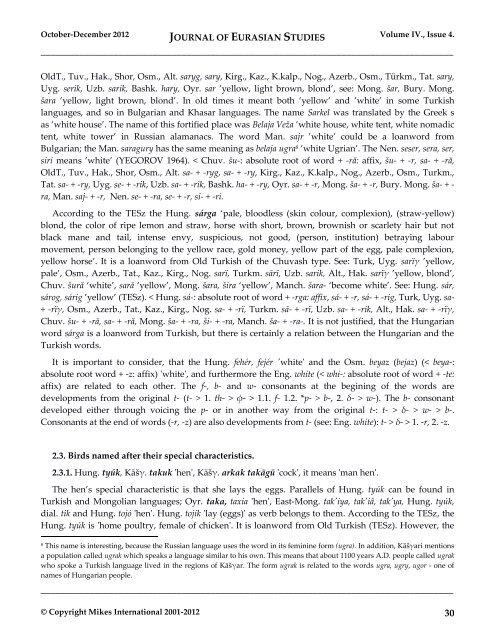You also want an ePaper? Increase the reach of your titles
YUMPU automatically turns print PDFs into web optimized ePapers that Google loves.
October-December 2012 JOURNAL OF EURASIAN STUDIES Volume IV., Issue 4.<br />
_____________________________________________________________________________________<br />
OldT., Tuv., Hak., Shor, Osm., Alt. saryg, sary, Kirg., Kaz., K.kalp., Nog., Azerb., Osm., Türkm., Tat. sary,<br />
Uyg. serik, Uzb. sarik, Bashk. hary, Oyr. sar ’yellow, light brown, blond’, see: Mong. šar, Bury. Mong.<br />
šara ’yellow, light brown, blond’. In old times it meant both ’yellow’ and ’white’ in some Turkish<br />
languages, and so in Bulgarian and Khasar languages. The name Sarkel was translated by the Greek s<br />
as ’white house’. The name <strong>of</strong> this fortified place was Belaja Veža ’white house, white tent, white nomadic<br />
tent, white tower’ in Russian alamanacs. The word Man. sajr ’white’ could be a loanword from<br />
Bulgarian; the Man. saragury has the same meaning as belaja ugra 8 ’white Ugrian’. The Nen. seser, sera, ser,<br />
siri means ’white’ (YEGOROV 1964). < Chuv. šu-: absolute root <strong>of</strong> word + -ră: affix, šu- + -r, sa- + -ră,<br />
OldT., Tuv., Hak., Shor, Osm., Alt. sa- + -ryg, sa- + -ry, Kirg., Kaz., K.kalp., Nog., Azerb., Osm., Turkm.,<br />
Tat. sa- + -ry, Uyg. se- + -rik, Uzb. sa- + -rik, Bashk. ha- + -ry, Oyr. sa- + -r, Mong. ša- + -r, Bury. Mong. ša- + -<br />
ra, Man. saj- + -r, Nen. se- + -ra, se- + -r, si- + -ri.<br />
According to the TESz the Hung. sárga ‘pale, bloodless (skin colour, complexion), (straw-yellow)<br />
blond, the color <strong>of</strong> ripe lemon and straw, horse with short, brown, brownish or scarlety hair but not<br />
black mane and tail, intense envy, suspicious, not good, (person, institution) betraying labour<br />
movement, person belonging to the yellow race, gold money, yellow part <strong>of</strong> the egg, pale complexion,<br />
yellow horse’. It is a loanword from Old Turkish <strong>of</strong> the Chuvash type. See: Turk, Uyg. sarïγ ’yellow,<br />
pale’, Osm., Azerb., Tat., Kaz., Kirg., Nog. sarï, Turkm. sārï, Uzb. sarik, Alt., Hak. sarïγ ’yellow, blond’,<br />
Chuv. šură ‘white’, sară ‘yellow’, Mong. šara, šira ‘yellow’, Manch. šara- ‘become white’. See: Hung. sár,<br />
sárog, sárig ’yellow’ (TESz). < Hung. sá-: absolute root <strong>of</strong> word + -rga: affix, sá- + -r, sá- + -rig, Turk, Uyg. sa-<br />
+ -rïγ, Osm., Azerb., Tat., Kaz., Kirg., Nog. sa- + -rï, Turkm. sā- + -rï, Uzb. sa- + -rik, Alt., Hak. sa- + -rïγ,<br />
Chuv. šu- + -ră, sa- + -ră, Mong. ša- + -ra, ši- + -ra, Manch. ša- + -ra-. It is not justified, that the Hungarian<br />
word sárga is a loanword from Turkish, but there is certainly a relation between the Hungarian and the<br />
Turkish words.<br />
It is important to consider, that the Hung. fehér, fejér 'white' and the Osm. beyaz (bejaz) (< beya-:<br />
absolute root word + -z: affix) 'white', and furthermore the Eng. white (< whi-: absolute root <strong>of</strong> word + -te:<br />
affix) are related to each other. The f-, b- and w- consonants at the begining <strong>of</strong> the words are<br />
developments from the original t- (t- > 1. th- > φ- > 1.1. f- 1.2. *p- > b-, 2. δ- > w-). The b- consonant<br />
developed either through voicing the p- or in another way from the original t-: t- > δ- > w- > b-.<br />
Consonants at the end <strong>of</strong> words (-r, -z) are also developments from t- (see: Eng. white): t- > δ- > 1. -r, 2. -z.<br />
2.3. Birds named after their special characteristics.<br />
2.3.1. Hung. tyúk, Kāšγ. takuk 'hen', Kāšγ. arkak takāgū 'cock', it means 'man hen'.<br />
The hen’s special characteristic is that she lays the eggs. Parallels <strong>of</strong> Hung. tyúk can be found in<br />
Turkish and Mongolian languages; Oyr. taka, taxia 'hen', East-Mong. tak'iya, tak'iâ, tak'ya, Hung. tyúk,<br />
dial. tik and Hung. tojó 'hen'. Hung. tojik 'lay (eggs)' as verb belongs to them. According to the TESz, the<br />
Hung. tyúk is 'home poultry, female <strong>of</strong> chicken'. It is loanword from Old Turkish (TESz). However, the<br />
8 This name is interesting, because the Russian language uses the word in its feminine form (ugra). In addition, Kāšγari mentions<br />
a population called ugrak which speaks a language similar to his own. This means that about 1100 years A.D. people called ugrak<br />
who spoke a Turkish language lived in the regions <strong>of</strong> Kāšγar. The form ugrak is related to the words ugra, ugry, ugor - one <strong>of</strong><br />
names <strong>of</strong> Hungarian people.<br />
_____________________________________________________________________________________<br />
© Copyright Mikes International 2001-2012 30

















